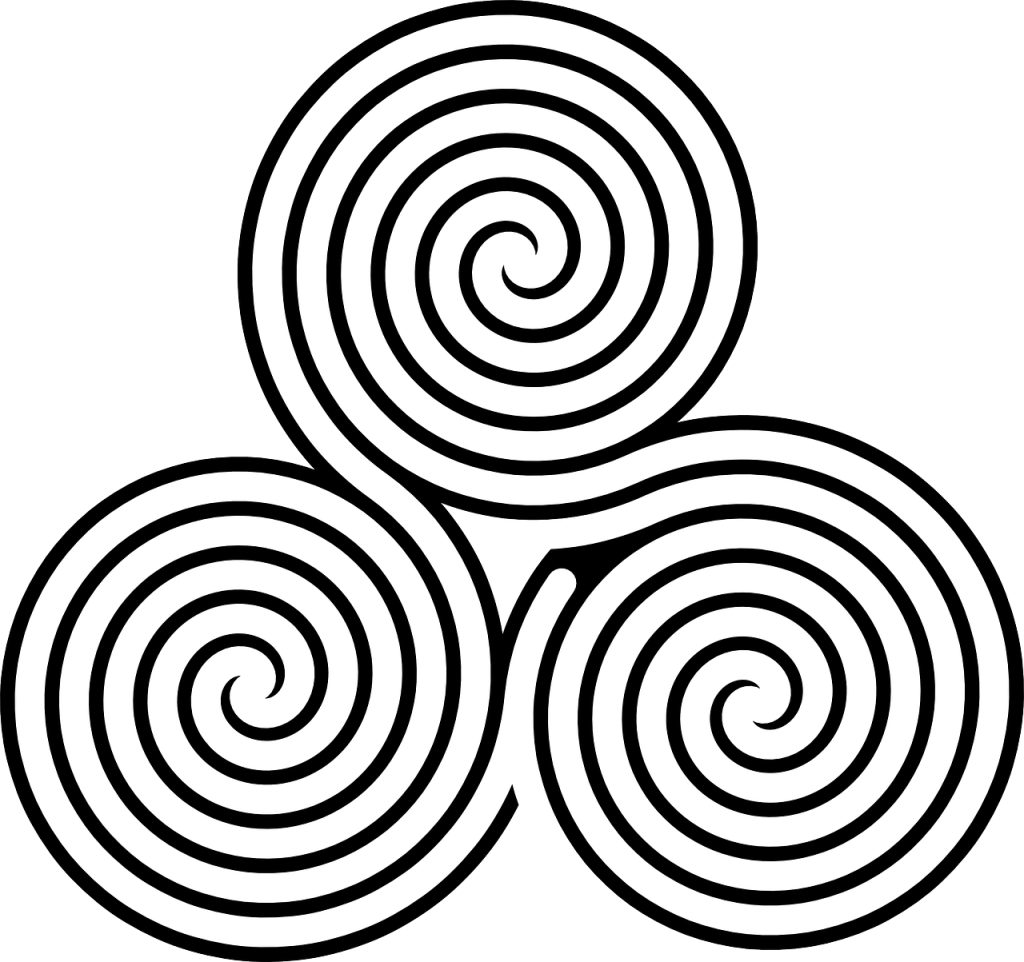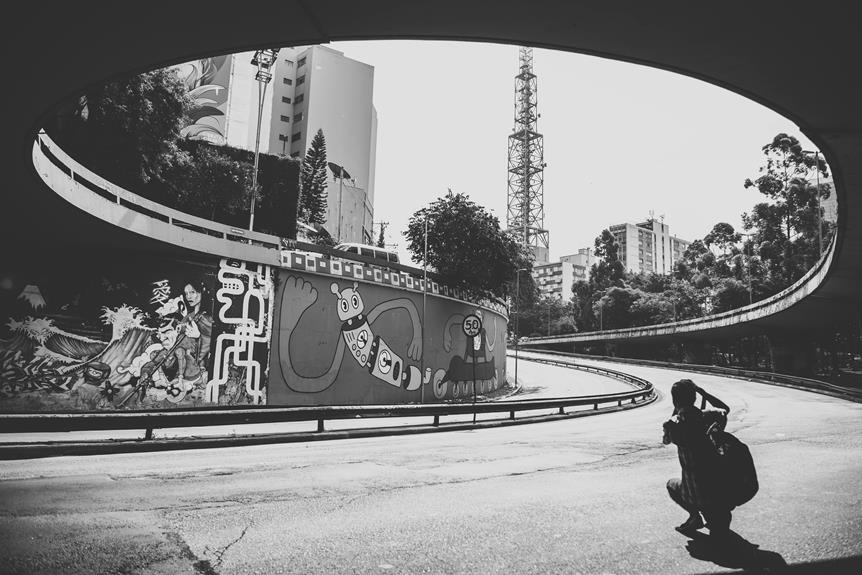Celtic Art

Celtic art, originating in the Bronze Age, reflects the complex cultural and spiritual life of ancient European Celtic tribes. You’ll find motifs like tri-spirals, intricate knots, and key patterns, each brimming with symbolic meaning. These designs often convey beliefs about the universe, spirituality, and eternal love. Masterpieces such as the Book of Kells and the Tara Brooch exemplify the exquisite craftsmanship in metalwork and illuminated manuscripts. Techniques involve intricate engraving, casting, and filigree, often using precious metals. Today, artists blend these ancient motifs with modern aesthetics in various mediums, enriching the narrative of Celtic art’s legacy. Discover more about its evolution and significance.
Key Points
- Celtic art originated in the Bronze Age, developed by European Celtic tribes.
- Key design elements include tri-spirals, knots, and key patterns with deep symbolic meanings.
- The Book of Kells and Tara Brooch are famous examples of Celtic artistry.
- Techniques feature knotwork, interlace, and metalworking with materials like bronze, gold, and silver.
- Modern interpretations blend traditional motifs with contemporary designs in jewellery, digital art, and fashion.
History and Origins
Celtic art’s origins trace back to the Bronze Age, signifying the rich cultural tapestry woven by various European Celtic tribes. During this era, you see the inception of unique artistic influences that distinguish Celtic art.
These tribes, spread across regions, contributed to a distinctive style that eschews straight lines in favor of more organic forms. The Bronze Age marked a significant period where these influences began to solidify, showcasing ornamental designs that are both intricate and symbolic.
The interconnectedness of the tribes facilitated the exchange of motifs and techniques, enriching the artistic tradition. By understanding these early influences, you gain insight into the foundational elements that shaped Celtic art’s evolution, persisting through time and geography.
Key Design Elements
Delving into the key design elements, you’ll find that tri-spirals, knots, and key patterns serve as the cornerstone of Celtic artistic expression, each imbued with deep symbolic meaning.
The tri-spiral, like the Triskele, symbolizes life force, while knots with continuous lines and rounded edges embellish Celtic crosses and designs.
Key patterns, composed of straight lines and triangle shapes, showcase the geometric patterns and intricate details characteristic of Celtic art. These elements find their place in rune carvings, metalwork, and woodwork across Europe.
Employing varied color combinations and artistic techniques, Celtic artists create visually enthralling pieces. These foundational designs reflect the culture’s deep appreciation for complexity and interconnectedness, evident in their craftsmanship’s meticulous execution.
Symbolism and Meanings
You’ll find that the symbolism in Celtic art goes beyond mere decoration, embedding deep spiritual and cultural meanings. Ancient patterns and motifs often reflect beliefs about the human soul and the universe, while spiritual symbols like the Celtic cross and tree of life highlight the connection between the physical and the mystical.
Understanding these elements offers insight into the cultural significance that these artworks held for the Celts.
Ancient Patterns and Motifs
Ancient Celtic patterns and motifs, such as the Tri-Spirals and intricate knots, are imbued with profound symbolism that reflects the culture’s beliefs and values.
Celtic knots, known for their continuous lines and rounded edges, often symbolize eternal love and interconnectedness, appearing on crosses and artifacts. These designs aren’t merely decorative; they convey deeper meanings tied to life’s cycles and spiritual harmony.
Patterns like the Key Patterns, with their straight lines and triangle shapes, further enrich Celtic art, revealing the culture’s artistic inspirations. Found on rune carvings, metalwork, and woodwork, these motifs express themes of love, harmony, friendship, and the connection between earth and heaven, making Celtic art a profound narrative of ancient beliefs.
Spiritual and Mystical Symbols
In Celtic art, spiritual and mystical symbols such as triskeles, knots, and the Celtic tree of life are imbued with profound meanings that reflect the culture’s deep connection to spirituality and the natural world. These symbols often encapsulate the eternal cycle and are rich in artistic interpretations.
- Triskeles: Signify the eternal cycle of life, death, and rebirth.
- Celtic knots: Represent interconnectedness and eternity.
- Celtic tree of life: Symbolizes the balance between earth and heaven.
- Spirituality: Reflected through harmony with nature.
- Artistic interpretations: Offer varied insights into ancient beliefs.
Cultural Significance in Art
How do the intricate symbols woven into Celtic art reveal the profound cultural significance and meanings that shaped the spiritual and social fabric of ancient Celtic societies? Symbols like the Triskele and spirals represent the life force and spiritual connection, respectively. Celtic knots, embodying love and friendship, highlight the values placed on relationships. The Celtic tree of life signifies balance and interconnectedness, bridging earthly and divine dimensions. These motifs reflect cultural influences and the artistic evolution of Celtic societies, offering artistic interpretations with contemporary relevance.
| Symbol | Meaning |
|---|---|
| Triskele | Life force |
| Spirals | Spirit and soul connection |
| Key Patterns | Common on crosses |
| Celtic Knots | Love, harmony, unbreakable bonds |
| Tree of Life | Balance, harmony, interconnectedness |
These symbols not only shaped ancient art but also resonate today, reflecting timeless values.
Famous Celtic Artworks
When exploring famous Celtic artworks, you can’t overlook the intricate beauty of the Book of Kells, the craftsmanship of the Tara Brooch, and the monumental significance of the Gundestrup Cauldron.
Each piece not only exemplifies the artistry of its time but also reflects the cultural exchanges and influences that shaped Celtic art.
Book of Kells
The Book of Kells, an illuminated manuscript from around 800 AD, stands as a pinnacle of Insular art, showcasing the remarkable skill and creativity of Columban monks in Ireland. As one of the most exquisite illuminated manuscripts, it employs advanced artistic techniques that demonstrate the monks’ devotion to Celtic Christianity. Its intricate designs feature vibrant colors, interlace patterns, and detailed depictions of animals and plants.
- Intricate interlace patterns: Exemplifies Celtic artistic complexity.
- Vibrant colors: Reflects the manuscript’s rich visual appeal.
- Elaborate calligraphy: Highlights the skillful artistry of the scribes.
- Biblical scenes: Merges religious devotion with artistic excellence.
- Ornamental pages: Enhances the manuscript’s overall grandeur.
Currently housed in Trinity College, Dublin, it remains an essential cultural treasure.
Tara Brooch
Explore the intricate craftsmanship of the Tara Brooch, a quintessential example of early medieval Irish metalwork that epitomizes the sophistication of Celtic artistry.
Discovered in 1850 and now housed in the National Museum of Ireland, this 8th-century artifact stands as a confirmation to the historical significance and artistic craftsmanship of its creators.
Adorned with gold filigree, amber, and colored glass, the brooch features complex interlacing patterns and animal motifs that are hallmarks of Celtic art.
The meticulous detail illustrates the advanced techniques employed by early medieval artisans, highlighting the cultural and artistic achievements of the period.
The Tara Brooch not only serves as a symbol of Celtic identity but also as a masterpiece of medieval decorative arts.
Gundestrup Cauldron
Dating back to the 1st century BC, the Gundestrup Cauldron stands as a demonstration of the sophisticated artistry and religious complexity of ancient Celtic cultures. Its intricate craftsmanship showcases detailed scenes of deities, animals, and mythical figures, reflecting significant influences and artistic techniques of the time.
The cauldron’s origins are debated, with possible Thracian, Celtic, or Roman roots, adding to its historical context.
Key aspects include:
- Intricate silverwork: Largest surviving European Iron Age silver item.
- Rich iconography: Depictions of gods and mythical beings.
- Conservation methods: Essential for preserving its detailed artistry.
- Cultural significance: Sheds light on Celtic religious beliefs.
- Archaeological importance: Offers insights into ancient artistic practices.
Understanding these elements enriches our appreciation of this remarkable artifact.
Techniques and Materials
Celtic art’s distinctive techniques, including knotwork, interlace, and spiral patterns, exemplify the intricate craftsmanship and symbolic depth of this ancient tradition. Metalworking methods, such as engraving, casting, and filigree work, demonstrate the technical prowess of Celtic artisans.
They drew artistic inspiration from nature, mythology, and spiritual beliefs, embedding profound symbolism into their creations. Traditional materials like bronze, gold, and silver were commonly used, with later incorporations of enamel and glass enhancing the aesthetic richness.
Contemporary adaptations of these materials continue to honor the legacy of Celtic art, blending historical techniques with modern innovations. The use of vibrant colors and stylized forms further distinguished Celtic art, making it a unique and enduring cultural expression.
Modern Interpretations
In contemporary times, artists skillfully merge traditional Celtic motifs with modern aesthetics, creating works that resonate with both historical reverence and innovative expression. By incorporating these motifs into various mediums, they embrace contemporary styles and innovative techniques.
You’ll find Celtic art in jewelry, paintings, and digital art, each piece exploring themes of identity, heritage, and spirituality.
- Jewelry: blending traditional knotwork with modern materials.
- Paintings: using vibrant colors to reinterpret ancient symbols.
- Digital art: creating intricate patterns with advanced software.
- Tattoos: merging traditional designs with modern tattooing methods.
- Fashion: integrating Celtic designs into contemporary clothing.
The enduring popularity of Celtic art today highlights a deep appreciation for its intricate and symbolic aesthetics, making it a timeless source of inspiration.
Frequently Asked Questions
What Is Meant by Celtic Art?
You’re looking at art characterized by intricate patterns and Celtic symbols like spirals and knots. Celtic art avoids straight lines, using geometric shapes to convey deep symbolic meanings rooted in spirituality, love, and harmony.
What Is the Most Famous Piece of Celtic Art?
You might consider the Great Torc from Snettisham or the Gundestrup cauldron as the most famous pieces. Both exemplify La Tène style, but don’t overlook Pictish stones, which also hold significant cultural importance.
Is Celtic Design Irish or Scottish?
You might wonder if Celtic design is Irish or Scottish. Actually, it spans various Celtic tribes. Both Irish and Scottish cultures contribute, seen in Celtic tattoos and knot patterns. Each region adds unique influences, enriching the tradition.
Is Celtic Culture Irish or Scottish?
You can’t limit Celtic culture to just Irish or Scottish origins. It spans across Europe, reflecting shared Celtic mythology and language. Both regions have distinct influences, but the broader Celtic heritage connects them and many other Celtic tribes.
Conclusion
By exploring Celtic art, you gain insight into a rich cultural tapestry woven with intricate designs, deep symbolism, and skilled craftsmanship.
The historical origins and key elements reveal the Celts’ profound connection to nature and spirituality.
Famous artworks and techniques showcase their artistic prowess.
Modern interpretations keep this ancient art form alive, blending tradition with contemporary creativity.
Ultimately, Celtic art’s enduring allure lies in its ability to transcend time, inviting you to appreciate its timeless beauty and significance.
Author: Jessica Hartley

